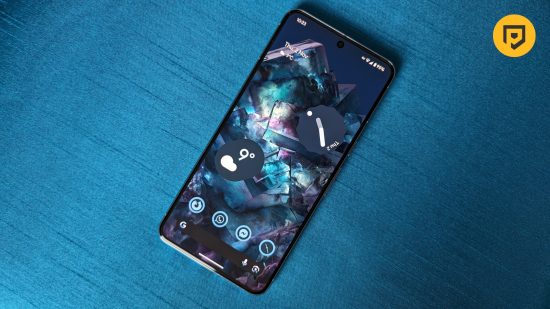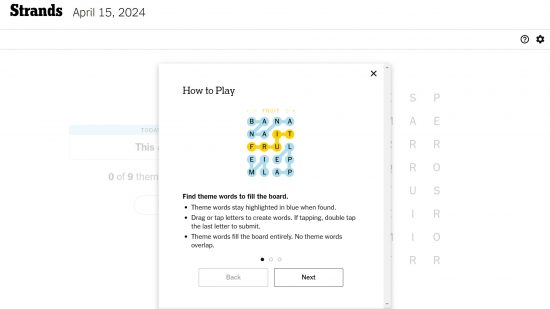Google Pixel 8 Pro review

The Google Pixel 8 Pro looks to be the smartphone of the future, seeking to leverage the power of artificial intelligence to push the quality of its software further than ever before. It’s also set to receive an unprecedented level of software and security support, seven years worth to be exact. While all of this sounds exciting in the immediate present, there are some things AI simply can’t fix that leave the Pixel 8 Pro feeling behind the curve in some areas.
To make one thing clear, the Pixel 8 Pro tops the best Google Pixel phones chart without question, much as it should be considering its near $1,000 asking price. It’s also perhaps the boldest from the brand, hoping to pioneer a future with AI at the helm of smartphones. It largely succeeds in this, at times to an eerie degree, but this focus leaves you wanting when it comes to gaming and creates uncomfortable questions concerning the Pixel 8 Pro’s value as a piece of hardware.
Pros
- Brilliantly bright LTPO OLED display
- Excellent photography and video capabilities
- Seven years of software and security updates
Cons
- Some software features aren’t available yet
- Tensor G3 chipset still lags behind Apple and Qualcomm
- Temperature sensor fails to justify itself
Price and availability
The Pixel 8 Pro is available from $999 / £999 for 128GB of storage, with 256GB and 512GB coming in at $1,059 / £1,059 and $1,179 / £1,179, respectively. There is also a 1TB option available for $1,399, but it’s only available with the Obsidian colorway. This new starting price makes the Pixel 8 Pro at least $100 more expensive than the Pixel 7 Pro and Pixel 6 Pro were at launch, matching the Apple iPhone 15 Pro and Samsung Galaxy S23 Plus.
In many ways, Google’s flagship feels appropriately priced given its generational improvements, most notably to the camera array and display, admirably holding its own against similarly priced competition in practically every way except gaming performance.
However, compared to its cheaper sibling, the Pixel 8, the added value that the Pixel 8 Pro offers becomes less obvious over time. This problem stems more from how solid a base Google crafted with the base model rather than questionable decisions made in the design of the Pro (except for the built-in thermometer). To be clear, there are advantages to opting for the flagship, but they undoubtedly appeal most to enthusiast photographers rather than more typical smartphone users.
If you’re the kind of person who spends the majority of the time on your smartphone taking photographs or shooting videos, the Pixel 8 Pro is the clear choice between the two. The power of its high-end and versatile array of camera lenses is simply awesome, whether you’re using the out-of-the-box camera settings or tweaking its ‘Pro’ settings. For everyone else, the sensible move is to save $300 / £300 and opt for the Pixel 8.
Specs
| Battery | 5,050 mAh |
| Display | 6.7-inch 120Hz LTPO OLED (1344 x 2992 pixels) |
| CPU | Google Tensor G3 |
| RAM | 12GB LPDDR5X |
| Storage | 128GB / 256GB / 512GB / 1TB |
| Front camera | 10.5MP (f/2.2) |
| Back cameras | 50MP main (f/1.68), 48MP ultrawide (f/1.95), 48MP telephoto (f/2.80) |
| Weight | 213g |
| Dimensions | 6.4 x 3.0 x 0.3 in (162.6 x 76.5 x 8.8 mm) |
| Colors | Bay, Obsidian, and Porcelain |
The internals of the Pixel 8 Pro aren’t a massive departure from the Pixel 7 Pro, with the arrival of the Google Tensor G3 chipset serving as the biggest difference between the two smartphones. Much as there are changes to the CPU, GPU, and other parts of the hardware, they’re more in service of enhancing AI features than they are pushing raw performance.
These enhancements are most apparent in features like Magic Editor, Magic Audio Eraser, and others, but Google is keen to highlight that Tensor G3 provides a suite of subtle improvements, too. These include better video recording, with higher levels of detail, more accurate colors, dynamic range, and contrast, all while requiring less power. None of this, however, is exclusive to the Pixel 8 Pro, with the Pixel 8 enjoying all of these perks too.
RAM receives a technical bump, shifting from LPDDR5 to LPDDR5X, though capacity remains the same as it has been since the Pixel 6 Pro at 12GB. This leaves the Pixel 8 Pro with 4GB more memory than the Pixel 8, and similarly priced competitors, but is more of a nice to have than an easily discernible advantage.
Features
Before touching on the new software features available in the Pixel 8 Pro, let’s talk about its temperature sensor. It’s hard to think of many general use cases where it benefits all potential buyers of this smartphone, besides specific examples like checking the warmth of baby formula. Sadly, this feels like a miss, and it’s doubtful that many will think twice if it doesn’t make a reappearance in future Pixels.
As ever, the focus with the Pixel 8 Pro is the software, and there’s plenty to talk about with Google going all-in on pushing the power of AI into every feature it can. The most compelling are currently ‘Magic Editor’ and ‘Best Take’. Currently is an important distinction here, as some of the features advertised as part of the Pixel 8 Pro package, namely ‘Video Boost’ and ‘Night Sight Video’, aren’t actually available yet and are due to arrive later in 2023.
Returning to what is available today, Best Take is an eerily powerful tool that forever transforms how you view group shots. Analyzing similar pictures in your Google Photos, the feature allows you to choose and transplant expressions from different photographs into an entirely new one. In a positive light, this removes the worry of an unfortunate blink spoiling an otherwise perfect photo but also, more worryingly, creates a moment that never actually existed.
These same concerns are all the more potent with Magic Editor, which essentially provides one of the most powerful photo editing suites available on a smartphone. With it, you can erase, resize, and transform the general appearance of objects and people to your heart’s content through the power of deep learning. In a metaphorical and literal sense, it can move mountains for you.
Before getting too carried away with how impressive Magic Editor is, it’s by no means faultless. Its biggest problem is that it requires an active internet connection, which is almost certainly in part to control how you use the feature. This becomes clear when prompted with a pop-up informing you that you can’t make a particular edit as it may violate Google’s GenAI terms. Then there’s the amount of time each change can take, keeping you waiting around for around 10-15 seconds.
The quality of the edits can vary greatly, too, with Magic Editor only able to do so much to save poorly taken photographs. The general rule of thumb is that you can only expect results of a similar quality to what you feed the feature in the first place.
This sentiment also applies to Audio Magic Eraser, which is surprisingly effective at identifying and removing rogue sounds from your videos. It has some rough edges, which Google can no doubt smooth out over time, still, it’s capable enough in its current form for a quick cleanup instead of using professional software or expertise to achieve the same effect.
Suffice to say, the Pixel 8 Pro is positively brimming with software features that no other smartphone can match right now. It’s not quite all-encompassing enough to outright replace desktop solutions like Photoshop, but there’s no denying how powerful it is, given its ease of use.
If the Pixel 8 Pro is missing one feature, it’s an ultra-sonic fingerprint scanner. The same optical solution that appears on the Pixel 7 Pro returns here, and it’s at best serviceable and at worst an annoyance. Google missed a trick here, as it has in previous years, by not swapping it out for a faster, more modern option, which would have improved the value of the smartphone more significantly than the temperature sensor.
Camera
As you might expect, the cameras on the Pixel 8 Pro are excellent, with each lens receiving an upgrade or several versus the Pixel 7 Pro. The ultrawide module has undoubtedly received the biggest glow-up of the array, jumping from a 12MP to a 48MP lens with a wider ƒ/1.95 aperture to boot. Wider apertures also appear on the main and telephoto lenses, clocked at a respective ƒ/2.80 and ƒ/1.68. The former gets multi-zone laser autofocus, too, but there appears to be little difference in its focussing abilities and speed versus even the Pixel 7.
Naturally, with such a stacked setup, the Pixel 8 Pro captures amazing photographs and video. Google has continued to refine its post-processing wizardry here, offering a top-tier out-of-the-box experience for those who want to capture moments in their best light with minimal fuss. This is true for portraits, landscapes, astrophotography, and more, with results that are vibrant, rich in contrast, and full of detail.
As the primary sensors on both the Pixel 8 Pro and Pixel 8 are the same, the quality of photos taken on that lens on both phones is identical. It isn’t until the ultrawide and telephoto lenses come into play that differences emerge, with much more detail retained in 5x, 10x, and even 30x shots on the Pixel 8 Pro. The advantages of its ultrawide’s higher megapixel count are less pronounced, and only the most keen-eyed should notice anything.
Exclusive to the Pixel 8 Pro are the aptly named ‘Pro’ controls, which allow you to tinker with settings such as ISO, shutter speed, white balance, and more. It also opens up options such as native 50MP captures as opposed to 12MP binning, as well as the ability to save images in the RAW format in addition to JPG. These options are welcome, though, slightly niche in their appeal given how solid the default experience is, with the increased megapixel count proving the most useful, even if it comes with increased delay in the camera viewport between shots.
Curiously, there’s no reason these controls are only available on the Pixel 8 Pro, with the Pixel 8 sharing the same chipset and main lens. While this does help to differentiate the two, it does leave you questioning the value of the Pixel 8 Pro past Google’s arbitrary software locks. After all, the manufacturer has already ported the camera software to other, older Tensor-based smartphones.
It’s unclear whether Google plans to launch this feature on other Pixel phones eventually. In our opinion, we’d rather see the tech brand addressing some of the rough edges in the Pixel 8 Pro’s camera software. The most egregious is undoubtedly the frankly horrible lens transition that’s anything but smooth. This oversight is less of a problem for photography but makes switching between the cameras while shooting video an unpleasant time. Then there are oddities like the forced 1.5x zoom and arbitrary 3.0x zoom cap for Portrait Mode, inexplicably shutting out the telephoto lens. These are all gripes that Google can fix with software updates, but this is the unfortunate state of things at the time of writing.
Touching briefly on the selfie camera, it’s had some minor spec changes but now features Phase Detection Auto Focus, so your selfies should hit their mark more often. It’s now secure enough to use as an unlocking method for banking apps and the like, too, thanks to some behind-the-scenes software tinkering from Google. Finally, we have to mention video performance. Things are much the same as they were on the Pixel 7 Pro, save for the addition of 24fps recording in both 1080p and 4K resolutions.
Design
Holding the Pixel 8 Pro in your hand, it quickly becomes clear that Google has made a number of small but welcome changes to its design language that help elevate the smartphone well above its predecessor. An example of this rethink is the single cutout for the camera array, in place of the two on the Pixel 7 Pro, providing a much cleaner look.
Where this becomes most transparent, however, is in the ergonomics of the Pixel 8 Pro. Gone are the sharp edges of the predecessor, replaced with much gentler, elegant rounded corners. Most pleasing, though, is the feel of its Gorilla Glass Victus 2 back, with a silky smooth texture that is so pleasant to the touch that it makes you wish all phones felt like this. Durable as it might be, many will understandably put a case on it, dampening the allure of an otherwise great part of the Pixel 8 Pro.
The Pixel 8 Pro is the best-looking phone Google has ever made, save for one flaw: its glossy aluminum frame. It pales in comparison to the smarter matte finish on the Pixel 8, especially given how more prone it is to both fingerprint smudges and scratches.
You can find the Pixel 8 Pro in three colorways: Bay, Obsidian, and Porcelain. Each is appealing in its own way, with Bay proving to be a welcome splash of vibrancy compared to the muted tones of the other two options.
Display
Serving as the debut of Google’s ‘Super Actua’ display, the Pixel 8 Pro literally shines brighter than most smartphones. It’s a far cry from the dim days of the Pixel 6 Pro, with a full-screen brightness of 1,600 nits in HDR and a whopping 2,400 nits peak brightness. These specs are as impressive as they sound, with photos, videos, and anything else you could want to view on a screen looking positively stellar.
The size of the display hasn’t changed from the Pixel 7 Pro, at 6.7-inches, but Google has opted to cut resolution down from 1440p to 1344p. While it’s unclear why it’s done this, it makes little difference in practice, given that the Pixel 8 Pro still clocks in at 489 pixels per inch regardless. That said, it does output at 1080p by default, yet it’s still plenty sharp, and you can barely notice much of a distinction between the full resolution.
Featuring an improved LTPO OLED panel, the Pixel 8 Pro now has a refresh rate of 1-120Hz versus the 10-120Hz range of the Pixel 7 Pro. This small change helps boost battery life, particularly if you’re someone who likes to leave the ‘Always On Display’ enabled.
Fans of the curved display found on the previous two Pixel Pro models may find it disheartening to learn that Google has given the Pixel 8 Pro a flat screen. Much as this may be less immersive for some, it does improve the resilience of the phone and mitigates potential glare caused by light reflecting on the curved edge.
Battery
You can expect to see anywhere from six to eight hours of screen time with the Pixel 8 Pro, with prolonged periods of standby states naturally pushing this further. Battery capacity has increased, generationally speaking, but only by a meager 50mAh, for a total of 5,050mAh.
When it comes to charging the Pixel 8 Pro, wired charging has seen an upgrade up to 30W, cutting charge time to around 90 minutes from empty to full. Wireless charging speeds remain unchanged at a maximum of 23W, yet this is only possible using the Pixel Stand 2, as Google has regretfully decided not to support the Qi2 standard here. As such, the Pixel 8 Pro can only pull up to 12W on every other wireless charger.
This disappointment aside, the Pixel 8 Pro provides more than enough juice to get you through the day and then some. Even in scenarios where you’re unable to recharge it overnight, the phone dutifully retains what charge it has, sipping rather than guzzling power to keep background tasks running efficiently.
Performance
The Pixel series isn’t exactly the leader of the smartphone pack in terms of gaming performance prowess, and the same is true for the Pixel 8 Pro. Much as the Google Tensor G3 chipset boats improvements over its predecessor, it still falls well short of what Apple and Qualcomm can achieve with their silicon.
That said, the Pixel 8 Pro is by no means a mobile gaming slouch. Both Call of Duty: Mobile and PUBG Mobile run great at maximum settings, with the 120Hz screen providing a buttery smooth experience.
However, while not a problem unique to the Pixel 8 Pro, the goalposts are beginning to shift, with Apple now packing enough power into its phones to run current generation console experiences. If Google and other Android manufacturers wish to keep up, they need to make serious improvements to future chipsets, and Tensor G3 is a ways off that goal.
Thankfully, the heating issues from the Pixel 7 series do not return on the Pixel 8 Pro. While the chassis can still get warm, it’s not nearly to the same degree (no pun intended), and there’s no risk of thermal throttling.
Should you buy the Google Pixel 8 Pro?
- Yes: If you want the best camera setup on an Android.
- Yes: If you watch lots of video content on your phone.
- Yes: If extended software and security updates are valuable to you.
- No: If you must have the highest gaming performance.
- No: If you don’t need a telephoto lens.
The Pixel 8 Pro is absolutely worth buying, particularly if you’re someone for whom photography is a high priority. Its camera array is one of the best in the market today, strengthened by the degree of customization offered by its ‘Pro’ controls and the power of Magic Editor to enhance and transform your shots. It should, theoretically, only get better with time, too, as the machine learning used in these applications gradually improves, in addition to when features like Video Boost and Night Sight Video arrive.
However, it’s important to note that much of what makes the Pixel 8 Pro special is down to software that seems arbitrarily exclusive when the Pixel 8 has the same Tensor G3 chipset. It’s not hard to imagine a future in which many of the features that differentiate the two devices end up with support for both, leaving the Pixel 8 Pro with its few but welcome hardware advantages (not including the temperature sensor, of course).
While Google promises to support the Pixel 8 Pro for the next eight years, there’s no way of knowing whether it’ll follow through, and consumers are right to be wary, given the company’s tendency to shut down projects. Just check out the seemingly ever-growing Google Graveyard. That said, we have to commend the tech giant for at least trying to make our smartphones last longer and reduce unnecessary e-waste.
In summary, the Pixel 8 Pro is impressive now and should hopefully age well, with its software suite only becoming more robust as the years pass. The nature of that support, however, we’re yet to see.
Alternatives
If, after all, you decide the Google Pixel 8 Pro isn’t the smartphone for you, here are a couple of suggestions for alternatives below.
Apple iPhone 15 Pro
At $999 / £999, the Apple iPhone 15 Pro starts at the same price as the Pixel 8 Pro and provides a photography experience that is comparable in quality. While Android users may have some difficulty adjusting to the differences and limitations of iOS, it does have unique strengths, like the ability to play games normally outside the reaches of smartphones, like Resident Evil 4 and Assassin’s Creed Mirage.
Google Pixel 8
Packing the same Google Tensor 3 chipset, the Google Pixel 8 is almost as powerful as the Pixel 8 Pro in many ways. While it lacks some of the niceties of its more premium sibling, it doesn’t skimp on all the areas that matter most and is, in many ways, the smarter purchase for most people, especially considering it’s $300 / £300 cheaper.
Google Pixel 8 Pro review
Google Pixel 8 Pro provides the most powerful combination of cameras and software features in an Android smartphone, in addition to an awesomely bright display. With the promise of seven years of support behind it, it should reliably occupy your pocket for years to come, even if its gaming performance is already behind the times.



